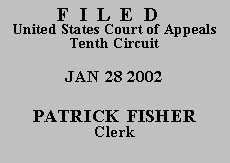

| UNITED STATES OF AMERICA,
Plaintiff-Appellee, |
|
| v. | |
| DARYL WAYNE WILKERSON, also
known as Daryl Wayne Haynes,
Defendant-Appellant. |
|
While on patrol on January 8, 1999, Officers Rodney Porter and Orin Tubbs of the Hobbs, New Mexico, Police Department made a u-turn and began following a brown Buick automobile. The automobile immediately turned right and began moving at a high rate of speed. As the officers followed, the automobile veered into the oncoming lane of traffic and then drove down the center of the street. Officer Porter activated the emergency lights on the patrol car. Officer Tubbs estimated that the Buick continued traveling for seven or eight blocks before it stopped.
Officer Porter approached the Buick and talked to Wilkerson, the driver. Officer Porter knew Wilkerson because he had arrested him the year before after discovering crack cocaine in Wilkerson's vehicle as the result of a tip. Officer Porter testified that he smelled alcohol on Wilkerson's breath. Wilkerson admitted he recently drank a beer. After he performed some field sobriety tests, Officer Porter arrested him for reckless driving and driving while intoxicated. According to Officer Porter, Wilkerson seemed nervous and gave several reasons for speeding (including that he was in a hurry to visit his girlfriend in the hospital, but he was driving in the opposite direction of the hospital). He also stated that he was tired and that he was scared.
While Officer Porter was talking to Wilkerson, Officer Tubbs talked to the passenger, Ronnie Meridyth. When Meridyth got out of the Buick, Officer Tubbs noticed his pants pocket was turned inside out. After arresting Wilkerson, the officers backtracked along the route they had followed the Buick and discovered a ball of electrical tape in the roadway. Inside the ball of tape were eight baggies containing 44.57 grams of a substance later determined to be crack cocaine. Fingerprints found on four of the baggies matched those of Wilkerson and on one of the baggies matched those of Meridyth.
Wilkerson's sole contention is there was insufficient evidence to convict him of aiding and abetting possession with intent to distribute cocaine. He argues that in order to convict him, the jury would have had to pile inference upon inference.
The question of whether the evidence at trial was sufficient is reviewed de novo. United States v. Bindley, 157 F.3d 1235, 1237 (10th Cir. 1998). We view the evidence and the reasonable inferences therefrom in the light most favorable to the government and ask whether a reasonable jury could find defendant guilty beyond a reasonable doubt. We reverse only if we conclude no reasonable jury could have reached the disputed verdict. Id.
The jury, as fact finder, has discretion to resolve all conflicting testimony, weigh the evidence, and draw inferences from the basic facts to the ultimate facts. However, we may not uphold a conviction obtained by piling inference upon inference. The evidence supporting the conviction must be substantial and do more than raise a suspicion of guilt.
United States v. Anderson, 189 F.3d 1201, 1205 (10th Cir. 1999) (internal quotations omitted).
The crime of possession of cocaine with intent to distribute requires that the government establish beyond a reasonable doubt that (1) defendant knowingly possessed the illegal drug; and (2) defendant possessed the drug with the specific intent to distribute it. United States v. Garcia, 182 F.3d 1165, 1174 (10th Cir. 1999). To prove the crime of aiding and abetting, the government must prove that defendant willfully associated himself with the criminal venture and sought to make the venture succeed through some action of his own. Anderson, 189 F.3d at 1207.
Contrary to Wilkerson's argument, it is not necessary to pile inference upon inference to sustain his conviction. Substantial circumstantial evidence exists from which a reasonable juror could conclude that Wilkerson knowingly aided and abetted the possession of cocaine with intent to distribute. When it appeared that the officers might stop the automobile he was driving, Wilkerson attempted to evade the officers by speeding. The pants pocket of the passenger in the Buick was inside out, suggesting he had discarded something from his pocket. This led the officers to retrace the path of the Buick and resulted in discovery of the drugs. Tests revealed the drugs to be crack cocaine in an amount so large and packaged in such a way that a reasonable juror could infer the drugs were intended to be distributed. At trial the government presented the testimony of Drug Enforcement Agent Mark Payne that, judging from the amount of cocaine and the manner in which it was packaged, it was his opinion the drugs were for distribution rather than personal use. Tests also revealed that Wilkerson's fingerprints were on four of the baggies in which the drugs were packaged, from which a reasonable juror could infer that Wilkerson had knowledge of the contents of the baggies. There was sufficient evidence to convict Wilkerson of aiding and abetting the possession of cocaine with intent to distribute.
AFFIRMED.
Entered for the Court
Mary Beck Briscoe
Circuit Judge
*. This order and judgment is not binding precedent, except under the doctrines of law of the case, res judicata, and collateral estoppel. The court generally disfavors the citation of orders and judgments; nevertheless, an order and judgment may be cited under the terms and conditions of 10th Cir. R. 36.3.
2. The Honorable Arthur L. Alarcon, United States Court of Appeals for the Ninth Circuit, sitting by designation.